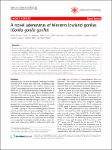A novel adenovirus of Western lowland gorillas (Gorilla gorilla gorilla)
Wevers, Diana
Leendertz, Fabian
Scuda, Nelly
Boesch, Christophe
Robbins, Martha
Head, Josephine
Ludwig, Carsten
Kühn, Joachim
Ehlers, Bernhard
Adenoviruses (AdV) broadly infect vertebrate hosts including a variety of primates. We identified a novel AdV in the feces of captive gorillas by isolation in cell culture, electron microscopy and PCR. From the supernatants of infected cultures we amplified DNA polymerase (DPOL), preterminal protein (pTP) and hexon gene sequences with generic pan primate AdV PCR assays. The sequences in-between were amplified by long-distance PCRs of 2 - 10 kb length, resulting in a final sequence of 15.6 kb. Phylogenetic analysis placed the novel gorilla AdV into a cluster of primate AdVs belonging to the species Human adenovirus B (HAdV-B). Depending on the analyzed gene, its position within the cluster was variable. To further elucidate its origin, feces samples of wild gorillas were analyzed. AdV hexon sequences were detected which are indicative for three distinct and novel gorilla HAdV-B viruses, among them a virus nearly identical to the novel AdV isolated from captive gorillas. This shows that the discovered virus is a member of a group of HAdV-B viruses that naturally infect gorillas. The mixed phylogenetic clusters of gorilla, chimpanzee, bonobo and human AdVs within the HAdV-B species indicate that host switches may have been a component of the evolution of human and non-human primate HAdV-B viruses.
Dateien zu dieser Publikation
Keine Lizenzangabe
Verwandte Publikationen
Anzeige der Publikationen mit ähnlichem Titel, Autor, Urheber und Thema.
-
2011-08-10ZeitschriftenartikelNovel adenoviruses in wild primates: a high level of genetic diversity and evidence of zoonotic transmissions. Wevers, Diana; Metzger, Sonja; Babweteera, Fred; Bieberbach, Marc; Boesch, Christophe; Cameron, Kenneth; Couacy-Hymann, Emmanuel; Cranfield, Mike; Gray, Maryke; Harris, Laurie A.; Head, Josephine; Jeffery, Kathryn; Knauf, Sascha; Lankester, Felix; Leendertz, Siv Aina J.; Lonsdorf, Elizabeth; Mugisha, Lawrence; Nitsche, Andreas; Reed, Patricia; Robbins, Martha; Travis, Dominic A.; Zommers, Zinta; Leendertz, Fabian; Ehlers, BernhardAdenoviruses (AdVs) broadly infect vertebrate hosts, including a variety of nonhuman primates (NHPs). In the present study, we identified AdVs in NHPs living in their natural habitats, and through the combination of ...
-
2009-12-01ZeitschriftenartikelNew Adenovirus in Bats, Germany Sonntag, Michael; Mühldorfer, Kristin; Speck, Stephanie; Wibbelt, Gudrun; Kurth, Andreas
-
2011-11-30ZeitschriftenartikelGenome analysis of bat adenovirus 2: Indications of interspecies transmission Kohl, Claudia; Vidovszky, Márton Z.; Mühldorfer, Kristin; Dabrowski, Piotr Wojtek; Radonić, Aleksandar; Nitsche, Andreas; Wibbelt, Gudrun; Kurth, Andreas; Harrach, BalázsThe genome of bat adenovirus 2 was sequenced and analyzed. It is similar in size (31,616 bp) to the genomes of bat adenovirus 3 and canine adenoviruses 1 and 2. These four viruses are monophyletic and share an identical ...

